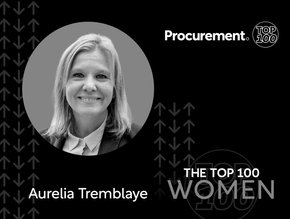10 lessons from CPOs on the polycrisis: Procurement Leaders

Describing itself as the world’s most valued procurement network – a community for CPOs and their leadership teams, Procurement Leaders has produced a guide that outlines ten ways Chief Procurement Officers (CPOs) can confront geopolitical, inflationary and disruptive challenges.
The guide describes the current multi-disruption landscape as a ‘polycrisis’ and compiles insights and lessons learned from CPOs across a range of sectors. It also contains predictions for the year ahead.
The guide recommends eight actions for CPOs to take, including securing executive buy-in, gaining transparency into the pressures they face and applying this visibility to create value across the supply base.
Procurement Leaders said: “Procurement has a vital role to play in tackling the challenges that businesses continue to face.
“From simmering geopolitical tensions to soaring energy costs and staff shortages, the challenges faced by businesses in recent months have been complex and interlinked, and procurement has a key role to play in tackling this ‘polycrisis’.”
The guide recommends eight actions for CPOs:
1. Significance of procurement increasingly acknowledged by exec teams
Amidst the polycrisis, a positive development has been the inclusion of procurement in high-level decision-making. The function has been tasked with ensuring uninterrupted supply chains, procuring critical safety gear, addressing the issue of inflated prices, and maintaining the smooth flow of logistics since the onset of the Covid-19 pandemic.
“The last couple of years have really shown businesses the value of procurement – and not just as a purchasing function/PO function, but the strategy of procurement and the value we bring in managing risk,” said Nestlé CPO Patricia Stroup.
“The executive team has acknowledged the procurement team’s work in keeping product on the shelf, managing cost and managing inflation. I don’t think this is just Nestlé, this is across the board.”
2. Cost remains crucial factor in decision-making, despite demands
Procurement has been tasked with numerous responsibilities, leading to a shift in the function's perception from solely cost reduction to a more multifaceted role. According to the Strategic Planning Guide 2023 by Procurement Leaders, for the first time ever, reducing supplier risk has surpassed cost reduction as the top priority of the function, albeit by a slim margin.
However, given the unpredictable economic climate, the conventional objective of cost reduction remains a critical aspect of procurement's role.
In the words of CME Group CPO Chuck Hatsis: “Cost is never going to go away in our function. We as a community may not like it, but in terms of how our CEO or our organisation looks at our function, it’s still highly important and largely how we are evaluated. It’s always going to be sexy to save money. The question is: what are the other areas on which we can focus?”
3. Procurement's growth aspirations at risk due to hiring freezes
Procurement has been tasked with various responsibilities, such as risk management, supplier diversity, and digital transformation, leading many CPOs to seek expansion of their teams to meet these objectives.
According to a procurement pulse survey conducted by Procurement Leaders in November, 50% of CPOs plan to increase their function's headcount, with only 14 planning to make reductions.
However, the increasingly challenging economic climate may thwart these plans. As companies worldwide fear an impending economic downturn, hiring freezes and job cuts are being implemented to maintain financial stability.
4. Procurement delving deeper into multiple tiers of supply chain
In today's environment, assessing the risks affecting only your suppliers and their immediate suppliers is no longer considered a comprehensive approach to risk management. Procurement teams are now taking a more thorough approach by monitoring the status of suppliers across multiple tiers of the supply chain. This strategy is demonstrated by companies such as Inmarsat, a satellite service provider.
Tim Snow, Inmarsat’s VP of procurement, commercial contracts and insurance, told Procurement Leaders: “Two years ago, driven by component shortages we had to start looking all the way down the supply chain – we go as deep as Tier-7 now – so we understand where to pinpoint risk.
“Often the smallest, cheapest little thing – a 20-cent chip – can prevent us from launching a satellite and earning billions of long-term revenue. So, we need to understand how we can mitigate them and the strategies we can employ in that mitigation.”
5. Procurement must comprehend input costs to combat inflation-driven profiteering
With energy costs surging and impacting the prices of other inputs, procurement is under immense pressure to restrict price increases to a minimum. However, certain companies are exploiting the situation.
According to a Procurement Leaders pulse survey, 71% of respondents reported observing forms of "profiteering" or "opportunism" by suppliers who have increased prices unnecessarily. A thorough understanding of suppliers' input costs is crucial to combat this issue during negotiations.
A procurement practitioner at a real estate company stated that they are requesting suppliers to provide detailed evidence of cost increases and their impact on output costs. They also cautioned suppliers that attempts to profit from the current inflationary environment could impact future business relations.
6. Robust relationships essential
Functions that maintain strong relationships, both with suppliers and cross-functional colleagues, are better equipped to navigate difficult situations, as demonstrated by chemicals company DuPont.
Miguel Gonzalez, CPO at DuPont, highlighted in a discussion with Procurement Leaders how his team's close partnerships with suppliers enabled them to overcome challenges related to logistics, supply chain security, and inflation.
“On the other side, is the very deep relationship integration with the businesses and the commercial teams,” he added. “All my procurement leaders sit within the business – not in procurement. They are part of the leadership teams and they report to the individual presidents. So that gives us insight and helps us educate and provide information that will help them.”
7. China's manufacturing dominance unlikely to face immediate threat
Geopolitical tensions between the US and China, coupled with Russia's incursion into Ukraine, which has drawn comparisons with a potential Chinese invasion of Taiwan, has caused several western corporations to reevaluate their dependence on Chinese manufacturing.
Some companies have already begun shifting their supply chains to other countries in the same region, such as Indonesia or Vietnam, or even closer to home. However, Chun-Yi Lee, director of the University of Nottingham's Taiwan Studies program, dampened hopes of an economic "decoupling" in the near future, given China's status as an established economic superpower.
She told Procurement Leaders: “With low-end assembling work with cheap labour, other east Asian countries can be a good alternative. But if we are talking about the high-end assembling work with more skilled labour, China has a clear advantage. As far as I can see, it is not going to be easy to completely abandon China as a supply base – it might even be impossible.”
8. Cooperation promotes progress in ESG initiatives
The rise of ESG (Environmental, Social, and Governance) initiatives on the agendas of corporate boards highlights the importance of procurement's role in this area. However, success in ESG cannot be achieved alone, and there is a growing understanding that collaboration between industries is needed to define and implement standards. For instance, AstraZeneca is among the ten companies that have joined Energize, a program initiated by Schneider Electric to promote the use of environmentally friendly electricity across the pharmaceutical value chain.
CPO John Dixon said: “It’s critical that the organisations that tend to use the same suppliers are connected in terms of how we communicate to that supply base, that we help them to understand because, often, they’re concerned about funds or they don’t know how to navigate the impact of dealing with the top-10 pharma companies. It’s an absolute imperative for us to work collaboratively across the sector.”
9. Aptitude for innovation remains strong
Despite facing numerous tactical challenges on a daily basis, many CPOs are prioritising innovation rather than deprioritising it. They believe that innovation plays a vital role in overcoming challenges during turbulent times.
Bob Murphy, CPO of IBM, told Procurement Leaders: “In these dramatic and turbulent times, we need innovation and creativity. We’ve been extremely engaged with our design and development teams so, if we could not get one component but we could find others of a similar nature, our design teams would rapidly assess, qualify and integrate those parts so we could ship our products.”
10. Threat of cyberattacks persists
According to Procurement Leaders, new research reveals that nearly all businesses, about 98%, have connections with a company that has been targeted by a cyberattack, and over 50% of them have indirect links to more than 200 fourth-party entities, such as their suppliers' suppliers, that have been compromised. As attacks become increasingly advanced, this underscores the critical role that procurement must play in protecting against such threats.
Time for action
As highlighted in Procurement Leaders' guide, CPOs must take a multifaceted approach to address the geopolitical, inflationary, and disruptive challenges facing their organisations.
Procurement has a vital role to play in tackling the complex and interlinked challenges of a polycrisis.
By taking the recommended actions, CPOs can create value, reduce risk and most importantly, ensure the resilience of their supply chains; helping their organisations emerge even stronger from these challenging times.
- Alberta Health Services’ CPO joins P&SC LIVE New YorkProcurement Strategy
- Michael Hourihan, General Mills CPO joins P&SC LIVE New YorkSustainable Sourcing
- Janelle Orozco, CPO at Kraft Heinz joins P&SC LIVE New YorkDigital Procurement
- Top 100 Women 2024: Barbara Kubicki, Wells Fargo – No. 3Procurement Strategy






